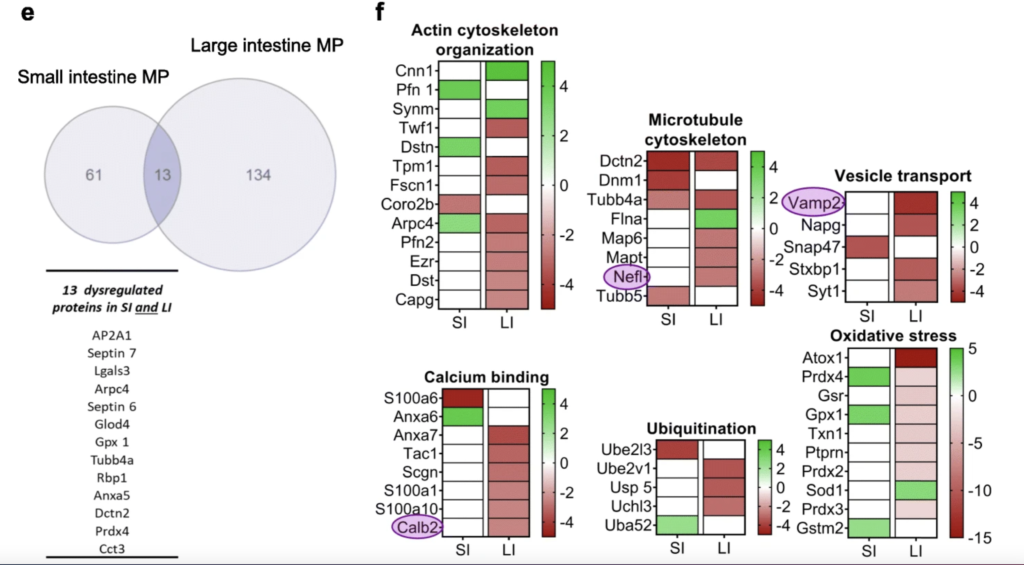
New data from a collaboration between University of Antwerp, the University of Applied Science Kaiserslautern, Saarland University, Heidelberg University, the Brain Mind Institute of EPF Lausanne and the Roche Innovation Centre Basel, show that in a mouse model of Parkinson’s disease there are distinct functional and molecular changes in the gut long before motoric disease onset.
Parkinson’s disease is a progressive nervous system disorder that predominately affects dopamine-producing (dopaminergic) neurons in a specific area of the midbrain called substantia nigra. Symptoms appear gradually, often starting with a barely noticeable tremor in just one hand. A person with Parkinson’s typically has involuntary shaking of parts of the body (tremor), stiff and inflexible muscles, and slow movement. Additionally, constipation is one of the most common symptoms of Parkinson’s, appearing in approximately half of all Parkinson’s patients and often preceding the onset of the movement impairments. Previous research has shown that the crosstalk between the gut and the brain during Parkinson’s pathogenesis is influenced by a disruption to the microbes (or microbiome) that live in the gut. This suggests that the gut motility deficits associated with Parkinson’s, such as constipation, are caused by alterations in the microbial composition of the gut.
As there is robust evidence that Parkinson’s disease may start in the gut, a research consortium coordinated by Prof. Karl-Herbert Schäfer, including the complementary expertise of Prof. Jean-Pierre Timmermans’ team, and collaborators in Germany and Switzerland set out to determine if they could detect appropriate candidate biomarkers in the gut of Parkinson’s disease mice before hallmark symptoms begin to manifest. They used 2-month-old pre-symptomatic Parkinson’s mice and examined their gut motility, the molecular composition of the gut, as well as the expression of regulating miRNAs.
“At the clinical onset of Parkinson’s disease the majority of dopaminergic neurons in the midbrain are already destroyed. So the lack of early biomarkers for this disease represents a major challenge for developing effective treatments”. – Prof. Timmermans
The researchers identified early functional and molecular gut-related biomarkers for Parkinson’s disease during the early stages of the disease, long before the onset of any motoric symptoms. They found that Nefl, Vamp2, and Calb2, and their regulating miRNAs, seem to be key players in the initiation of the disease. These proteins and miRNAs play a role in cytoskeleton assembly, oxidative stress, ubiquitin-proteasome degradation, synaptic transmission, and calcium signaling, and may contribute to gut dysfunction during early Parkinson’s disease.

In the future, minimally invasive gut biopsies could be collected for early detection of Parkinson’s disease. Screening of gut tissue and/or the gut microbiome could aid with diagnosing Parkinson’s disease in its early stages. This could then facilitate early and effective treatment or could even prevent Parkinson’s disease from developing.
Further reading: Gries M, Christmann A, Schulte S, Weyland M, Rommel S, Martin M, Baller M, Röth R, Schmitteckert S, Unger M, Liu Y, Sommer F, Mühlhaus T, Schroda M, Timmermans JP, Pintelon I, Rappold GA, Britschgi M, Lashuel H, Menger MD, Laschke MW, Niesler B, Schäfer KH. Parkinson mice show functional and molecular changes in the gut long before motoric disease onset. Mol Neurodegener. 2021 Jun 2;16(1):34. doi: 10.1186/s13024-021-00439-2. PMID: 34078425; PMCID: PMC8170976.
This work was partly supported by the German Ministry of Education and Research and a grant from the Deutsche Forschungsgemeinschaft. Open Access funding by Projekt DEAL.
Image adapted from https://doi.org/10.1186/s13024-021-00439-2, under a Creative Commons Attribution 4.0 International License, http://creativecommons.org/licenses/by/4.0/.
